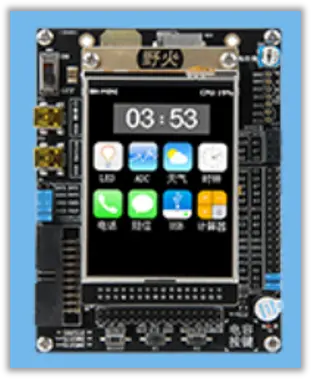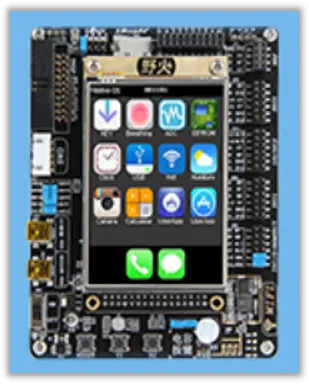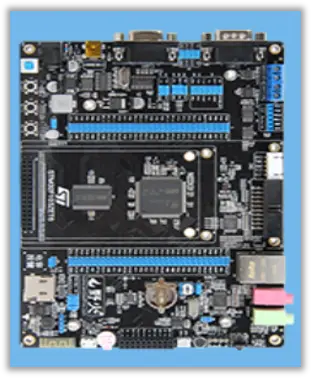ESP32 DevKitC development board
● ESP32 DevKitC description

ESP32 DevKitC
The ESP32 DevKitC is a small entry-level board that uses the ESP32-WROOM-32U and ESP32-WROOM-32D modules to support Wi-Fi and Bluetooth functions. ESP32-Devkitc development board is mainly used to develop the functions of peripheral modules. The pins of the ESP32 integrated on the ESP32 Devkitc have been brought out, with rich peripherals and optimized pin layout, helping users to quickly realize product development. The ESP32-WROOM-32U and ESP32-WROOM-32D modules are Espressif general-purpose Wi-Fi + Bluetooth modules, which are powerful and versatile, and can be used for low-power sensor networks and demanding tasks, such as voice Encoding, audio streaming and MP3 decoding, etc.
● ESP32 Devkitc datasheet
| Main components | Basic introduction |
|---|---|
| ESP32-WROOM-32 | ESP32-WROOM-32 |
| EN | reset key |
| Boot | Download key. Press and hold the Boot key and press the EN key at the same time, (Do not release the Boot key at this time) Enter the "Firmware Download" mode and download the firmware through the serial port. |
| USB-to-UART bridge | Single-chip USB-UART bridge. Transfer rates up to 3 Mbps are available. |
| Micro USB interface | The USB interface can be used as the power supply for the circuit board, or the communication interface for connecting the PC and the ESP32-WROOM-32 module. |
| sv Power On LED | When the board is powered on (USB or external 5V), this indicator will be on. For more information, see the schematics in the related documentation. |
| Io | Most of the pins of the module on the ESP32 devkitc board have been led out to the pin headers of ESP32-Devkitc. Users can program the ESP32 to realize various functions such as PWM, ADC, DAC, I2C, I2S, SPI, etc. |
FLASH: 4MB
Power supply DIANY: 5V/3V (only one power supply can be used, not connected at the same time, otherwise the module will burn out)

Note: The ESP32 devkitc pins D0, D1, D2, D3, CMD and CLK are used for the internal communication between the ESP32 chip and the SPI flash, and are concentrated on both sides of ESP32-DevKitC near the USB port. Generally speaking, these pins should not be connected, otherwise it may affect the operation of SPI flash / SPI RAM.
● ESP32 Devkitc Module comparison
| module | ESP32-WROOM-32D | ESP32-WROOM-32U |
|---|---|---|
| SPI Flash | 32 Mbit,3.3V | 32 Mbit,3.3 v |
| crystal oscillator | 40 MHz | 40 MHz |
| antenna | Onboard Antenna | U.FL socket, need to use with IPEX antenna |
| Module size (mm) | (18.00+0.10)×(25.50+0.10)×(3.10+0.10) | (18.00+0.10)×(19.20+0.10)×(3.20+0.10) |
The core of the ESP32-WROOM-32D and ESP32-WROOM-32U modules is the ESP32-DOWD chip, which belongs to the ESP32 series and is scalable and adaptive. The two CPU cores can be controlled independently. The clock frequency can be adjusted from 80 MH to 240 MHz. The user can cut off the power to the CPU and use the low-power coprocessor to continuously monitor the state changes of peripherals or whether some analog quantities exceed thresholds. The ESP32 Devkitc board integrates a wealth of peripherals, including capacitive touch sensors, Hall sensors, SD card interfaces, and Ethernet interfaces. High-speed SDIO/SPI, UART, 12S and I2C, etc.
The difference between ESP32-WROOM-32D and ESP32-WROOM-32U is that ESP32-WROOM-32U integrates a U.FL socket.
● ESP32 Devkitc board Features
The ESP32 module used by the ESP32 Devkitc board integrates traditional Bluetooth, Bluetooth low energy and Wi-Fi chips, so the ESP32-DevKitC development board has two IoT functions, Bluetooth and WIFI. Wi-Fi supports a wide range of communication connections, and also supports direct connection to the Internet through routers; while Bluetooth allows users to connect mobile phones or broadcast BLE Beacon for signal detection.
ESP32 Devkitc board supports data transfer rates up to 150 Mbps and antenna output power up to 20 dBm for maximum range wireless communication.
ESP32 Devkitc board has industry-leading technical specifications and excellent performance in terms of high integration, wireless transmission distance, power consumption, and network connectivity.
The ESP32 chip integrated in the ESP32 DevKitC has a sleep current of less than 5 µA, making it suitable for battery-powered wearable electronics. Moreover, the operating system of the ESP32 chip is freeRTOS with LwIP, and it also has built-in TLS 1.2 with hardware acceleration function, and supports OTA encryption upgrade, which is convenient for users to continuously upgrade.
● ESP32-WROOM-32D & ESP32-WROOM-32U Product Specifications
| Category | Project | Specifications |
|---|---|---|
| Certificate | RF Certification | FCC/CE-RED/IC/TELEC/KCC/SRRC/NCC |
| Wi-Fi Certification | Wi-Fi Alliance | |
| Bluetooth certification | BQB | |
| Environmental certification | REACH/RoHS | |
| Test | reliability | HTOL/HTSL/UHAST/TCT/ESD |
| Wi-Fi | protocol | 802.11 b/g/n (802.11n, up to 150 Mbps) |
| A-MPDU and A-MSDU aggregation with 0.4 µs guard interval support | ||
| Frequency Range | 2.4 GHz ~ 2.5 GHz | |
| Bluetooth | protocol | Compliant with Bluetooth v4.2 BR/EDR and BLE standards |
| radio frequency | NZIF receiver with –97 dBm sensitivity | |
| Class-1, Class-2 and Class-3 Transmitters | ||
| AFH | ||
| audio | CVSD and SBC audio | |
| hardware | Module interface | SD Card, UART, SPI, SDIO, I2C, LED PWM, Motor PWM, I2S, IR, Pulse Counter, GPIO, Capacitive Touch Sensor, ADC, DAC |
| On-chip sensor | Hall sensor | |
| Integrated crystal oscillator | 40 MHz crystal | |
| Integrated SPI flash 1 | 4 MB | |
| Working voltage/supply voltage | 3.0 V ~ 3.6 V | |
| Working current | Average: 80 mA | |
| Supply current | Minimum: 500 mA | |
| Recommended Operating Temperature Range 2 | –40 °C ~ +85 °C | |
| Moisture Sensitivity Level (MSL) | Level 3 |
● ESP32 DevKitC board advantages
• Support Wi-Fi & Bluetooth connection
ESP32 DevKitC is a small development board based on ESP32 module, which supports Wi-Fi and Bluetooth functions. The ESP32 DevKitC board has a wealth of peripherals, and users can easily realize product development.
• Easy and fast development
The ESP32-DevKitC development board has excellent RF performance, and users do not need to consider RF and antenna design when designing and developing applications. The basic system requirements are already included on the ESP32 DevKitC board, and users only need to connect the USB cable to develop.
• Flexible and rich features
The ESP32-DevKitC has a complete circuit to support the ESP32-WROOM, ESP32-WROVER and ESP32-SOLO series modules, including important components such as the USB-UART bridge, Reset and Boot keys, LDO voltage regulator and Micro-USB connector . The key GPIO ports have been brought out for developers to use.
• Easy to connect to the breadboard
The ESP32 DevKitC board has optimized pin layout, which is convenient for users to plug it into a ESP32 devkitc breadboard for development and debugging. The on-board LDO is brought out to supply power to external components. The ESP32-DevKitC groups different peripheral interfaces to help users get started with product development easily.
• Amazon Certified Devices
The ESP32 DevKitC board is certified by Amazon AWS.
The ESP32 DevKitC board supports both Espressif's open source IoT development framework ESP-IDF and FreeRTOS. Users can easily connect to AWS IoT, AWS Greengrass and more rich AWS services through FreeRTOS.
● ESP32 Devkitc schematic - circuit diagram
● ESP32-WROOM-32D module circuit diagram

● ESP32-WROOM-32U module circuit diagram

● ESP32 Devkitc schematic - peripheral design circuit diagram
The application circuit diagram of the connection between the development board module and peripheral devices (such as power supply, antenna, reset button, JTAG interface, UART interface, etc.).

● ESP32 DevKitC board Application field
The ESP32-DevKitC development board supports Wi-Fi one-key network configuration, voice wake-up, voice recognition and cloud platform access, etc. It is suitable for the development of various audio and AIoT applications, such as Wi-Fi and Bluetooth speakers, voice remote control, Voice robots, smart toys, and voice-enabled smart home devices.








